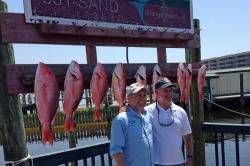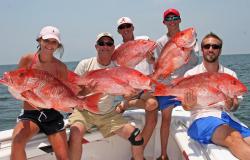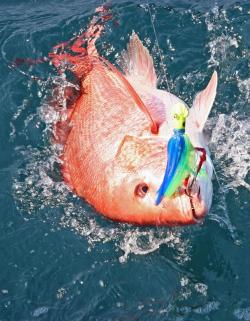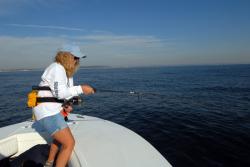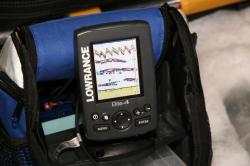Gulf States Continue to Work Towards Regional Red Snapper Control
By David Rainer
Alabama Department of Conservation and Natural Resources
from The Fishing Wire
To borrow from an old song from the holidays that I was forced to endure for six years as a snaggle-toothed youngster, “All I want for Christmas are my two red snapper.”
It’s obviously not going to happen in a couple of weeks, but there is hope the situation will look much better in the near future.
Rep. Bradley Byrne, right, of Alabama’s First District and Rep. Steve Scalise from Louisiana show off the red snapper catch after a trip out of Orange Beach this past summer. (ADCNR)Congressman Bradley Byrne, Alabama’s U.S. Representative from the First District, and Alabama Marine Resources Director Chris Blankenship think a plan to move red snapper management to regional control could become a reality.
“We’re optimistic going into the new year that we will have a legislative solution in the first half of the year, in time enough to save our red snapper season for next summer,” Congressman Byrne said. “What we did, in committee, is we amended the reauthorization of the Magnuson-Stevens Act, the law that governs the fisheries of the United States.
“That language does a couple of things. First is it pushes all Gulf states’ (state waters) borders out to nine miles. Secondly, it relieves the Gulf states, when it comes to reef fish, from having to comply with the quotas established under Magnuson. Thirdly, it puts into the place of NOAA (National Oceanic and Atmospheric Administration), which currently does the stock assessment, the Gulf States Marine Fisheries Commission, which is different from the (Gulf of Mexico Fishery Management) Council.”
Congressman Byrne said he and many others he has spoken to believe the data collected by the Gulf States Marine Fisheries Commission (GSMFC) would be much more reliable than the data currently used by NOAA.
“We would get better science,” he said. “We would no longer use the scientists used by NOAA down in Miami. We would use regional scientists, using Dr. Bob Shipp as an example. I feel confident, as does Chris Blankenship, that we will get accurate science as to the health of the stock, which is very healthy, but also more reliable data on the size of the catch. Chris has good information that NOAA is overestimating the number of snapper we are catching. So if you underestimate the stock and overestimate the catch, that’s going to artificially skew the season to be much smaller than necessary.”
The data from Blankenship that Congressman Byrne referred to came from the Red Snapper Reporting System, which was implemented by Alabama Marine Resources for the 2014 season. NOAA estimated the catch off Alabama during the nine-day federal season at slightly more than 1 million pounds. The data collected through the mandatory Red Snapper Reporting System indicated Alabama anglers landed 418,000 pounds of red snapper.
Congressman Byrne invited fellow Congressman Steve Scalise (R-Louisiana) on a red snapper fishing trip this past summer to give the new House Whip an idea of how outstanding the fishing is off the Alabama Gulf Coast.
“That was a great opportunity for Congressman Scalise to go out and see just how plentiful the stock is,” Congressman Byrne said. “That’s important because I will be on the Natural Resources Committee next year, so I can drive it through committee. But getting it up on the House floor for a vote is another thing. To have the Whip as an ardent advocate for it really does help. That’s one of the reasons I’m optimistic.
“You may not have your two red snapper for this Christmas, but you may have it for next Christmas. That’s what we’re working on. That’s our goal.”
Blankenship was invited by Congressman Byrne to testify before the House’s Natural Resources Committee recently in Washington.
“I’m glad Congressman Byrne and the Natural Resources Committee asked me to come to Washington to talk about what we’re doing in Alabama and what we’re doing on red snapper,” Blankenship said. “I think it went very well. We talked about our Red Snapper Reporting System and what we’re doing with the University of South Alabama to get information that goes into the stock assessment
“I think it was really eye-opening for some of the congressmen on that committee to see what a small state like Alabama is doing when the federal government is getting all this money to manage the fishery and doing such a poor job of it. I think it was very well-received.”
During those committee hearings, Congressman Byrne grilled Samuel Rauch from the National Marine Fisheries Service (NMFS) about the enormous NMFS budget of almost $900 million and how that expenditure failed to produce reliable fisheries data.
“The three things I stressed in my testimony started with what a great red snapper fishery we have off Alabama because of all the work we’ve done over several decades to build artificial reefs,” Blankenship said. “That laid the foundation on why that fishery is so economically important to our state.
“The second thing is we had to implement our own Red Snapper Reporting System because the information gathered by the federal government through its program we felt was incorrect.
“The third thing we talked about was the stock assessment and how NOAA, in their sampling protocol, basically excludes artificial reefs. So we talked about the work we’re doing off Alabama, that we’re paying for out of our own pockets, because NOAA is excluding the artificial reef zones.”
The obviously defensive Rauch said that some of the artificial-reef data has been used in the last stock assessment, although he admitted it was not a large factor.
Blankenship said that is exactly the problem.
The Congressmen are working on legislation that would give the Gulf states regional control of the red snapper fishery and extend the boundary for state waters of each of the Gulf states to 9 miles. (ADCNR)“What NOAA did was down-weighted our information because, in their opinion, it wasn’t as valuable as the data they collected,” Blankenship said. “They didn’t use our information at the same level or with the same importance in the model. So we’re really striving in the next red snapper stock assessment that our work will be used the way it should be in the model.
“And I have to commend Congressman Byrne. He was very well-prepared. He’s been down several times to go out on the boat when the University of South Alabama puts the cameras down to see what’s on the bottom around the reefs. He was prepared to ask those hard questions and be able to show the fallacies in the red snapper management where we are now. I have no doubt that he will continue to bird-dog this issue in the next Congress in January.”
Blankenship said he fielded several questions during the hearing and meetings with congressmen after the hearings on how Alabama could manage the fishery.
“The things we are doing in Alabama show that we can manage this fishery regionally,” he said. “We don’t need to have it managed by the federal government. Some changes to federal law would give us the flexibility and opportunity to manage the fishery. We can handle it here in Alabama. I think it meant a lot for them to see that the states are willing to do that.”
A regional management plan is still working through the Gulf Council process as well. The next Gulf Council meeting is scheduled for Jan. 26-30, 2015, at the Grand Hotel in Point Clear, Ala.
Blankenship said he’s not sure snapper fishermen will see relief in 2015, but he does think 2016 holds a great deal of promise.
“If they start using our red snapper data and get an update on the stock assessment, I hope to see the season back up to between 30 and 60 days in 2016,” Blankenship said. “The stock is required to be rebuilt by 2032, and we’re meeting those goals much quicker than that.
“It’s not a stock that’s in trouble. The federal management has just not kept up with the growth of the stock. We need to break that paradigm and get us off this merry-go-round we’re on at the federal level.”
PHOTOS: (ADCNR) Rep. Bradley Byrne, right, of Alabama’s First District and Rep. Steve Scalise from Louisiana show off the red snapper catch after a trip out of Orange Beach this past summer. The Congressmen are working on legislation that would give the Gulf states regional control of the red snapper fishery and extend the boundary for state waters of each of the Gulf states to 9 miles.
